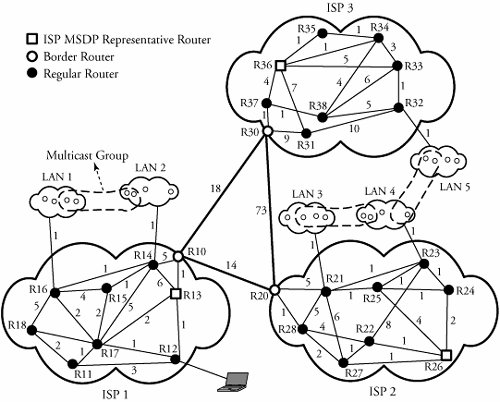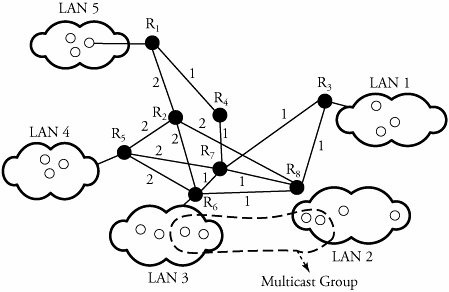Section 15.6. Exercises
| 1. | For sending a message from a point to multiple points, compare the trade-offs of using multiple unicast connections, and using any multicast approach, such as DVMRP, explained in this chapter. |
| 2. | Discuss the efficiency of MOSPF if the sparse-mode algorithm is used. |
| 3. | Consider Figure 15.5, and assume that we want to implement MOSPF from a server in LAN 1 to a multicast group of five members, three group members in LAN 3 and the two others in LAN 4. Also assume that the cost of each link is indicated by the sum of two ending routers' subscripts. For example, the cost of link R 3 to R 8 is 11. If a router ends a LAN, the cost of its associated link is assumed to be 1.
|
| 4. | To optimize the routing delay in a sparse-mode PIM:
|
| 5. | Consider Figure 15.6, and assume that we want to implement sparse-mode PIM from a server in LAN 1 to a multicast group of five members, with three group members in LAN 3 and the two others in LAN 4. Also assume that the cost of each link is indicated by the sum of two ending routers' subscripts. For example, the cost of link R 3 to R 8 is 11. If a router ends a LAN, the cost of its associated link is assumed to be 1.
|
| 6. | Repeat exercise 5, but this time use the CBT protocol. |
| 7. | In Figure 15.16, five LANs, 1 through 5, are networked through their associated routers, R 3 , R 8 , R 6 , R 5 , and R 1 . The cost of each link is indicated in the figure. A server in LAN 1 wants to send messages to the indicated multicast group.
Figure 15.16. Exercise 7 example for multicast protocols |
| 8. | For a global number of copies F = 7, use the tree-based multicast algorithm in a B 16,2 copy network, and show details of stage-by-stage copying. |
| 9. | Three major Internet service provider domainsISP 1, ISP 2, and ISP 3 are connected through three border routers: R10, R20, and R30, respectively, as shown in Figure 15.17. All three ISPs agree to use MSDP for interdomain multicasting. Each domain has selected a router as its ISP MSDP representative, which can also be used as a rendezvous point, if needed. A source in ISP 1 wants to multicast messages to three groups located in various geographical locations, as shown. ISP 1 uses MOSPF, and IPS 2 and ISP 3 use sparse-mode PIM for intradomain multicasting. The cost of each link (equal in both directions) is indicated in the figure.
Figure 15.17. Exercise 9: using MSDP for interdomain multicasting and MOSPF and sparse-mode PIM protocols for intradomain multicasting |
| 10. | For a global number of copies F = 7, use the Boolean splitting multicast algorithm in a D 16,2 copy network. Output ports 1, 2, 3, 7, 10, 12, and 15 receive a copy of packet.
|
| 11. | We want to show the copying mechanism in the switch fabric of routers whose global number of copies F = 5. The switch fabric is an Omega network 8,2 that has r = 6 stages.
|
| 12. | Consider a small switch fabric of 4 x 4 crossbar. Design the multicasting portion of its input port processor. Present all the hardware details. |
| 13. | Computer Simulation Project . Use the computer program you developed for the simulation of the seven-node network in Chapter 7 and modify it to model the network shown in Figure 15.16. Simulate a sparse-mode PIM for multicasting from router R 1 to four recipients located in a multicast group spread over a wide geographic area.
|
EAN: 2147483647
Pages: 211
- Article 324 Flat Conductor Cable Type FCC
- Article 348 Flexible Metal Conduit Type FMC
- Article 392 Cable Trays
- Article 500 Hazardous (Classified) Locations, Classes I, II, and III, Divisions 1 and 2
- Example No. D2(a) Optional Calculation for One-Family Dwelling Heating Larger than Air Conditioning [See Section 220.82]
